The Association for Mormon Letters Awards were presented online on May 2, 2020. You can watch the awards ceremony, produced by AML President Eric W. Jepson, and featuring video acceptance speeches from many of the winners, in this Youtube presentation. Below is each award winner, along with the award citation, written by the judges.

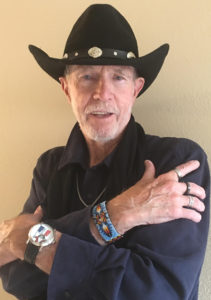 R. A. Christmas was presented with the Association for Mormon Letters Lifetime Achievement Award.
R. A. Christmas was presented with the Association for Mormon Letters Lifetime Achievement Award.
James Arrington was presented with the Smith-Pettit Foundation Award for Outstanding Contribution to Mormon Letters.
Special Award in Literature and Art
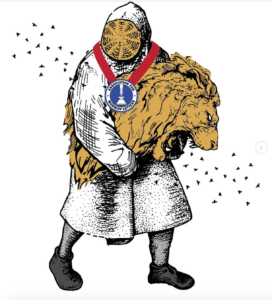 Issues 1 (“God and My Ex”) and 3 (“Deseret Brands Vol 1”), by LAZERos (Laz)
Issues 1 (“God and My Ex”) and 3 (“Deseret Brands Vol 1”), by LAZERos (Laz)
Issues 2 (“Apocrypha”) and 5 (“Spells for Many Blessings”), by The Desert Prophet (Camilla Stark)
Issue 4 (“The ARCH-HIVE Post”), by Saint Michael (McKay Rappleyea)
HIVE ZINE creators LAZERos, The Desert Prophet (Camilla Stark), and Saint Michael (McKay Rappeleyea) excel at exploring dichotomies. Not only do they strive to address the sacred juxtaposed against the profane, they similarly place pop Americana culture in the same space with Mormon thought and practice. Always blending genre with form, they ask the question, what is Mormon art?

 In a similar manner the original Millennial Star was a pamphlet and by-product of a larger movement, the five HIVE ZINE publications, the publication is a by-product of the authors’ larger mission to act fundamentally as a collective, called the ARCH-HIVE.
In a similar manner the original Millennial Star was a pamphlet and by-product of a larger movement, the five HIVE ZINE publications, the publication is a by-product of the authors’ larger mission to act fundamentally as a collective, called the ARCH-HIVE.
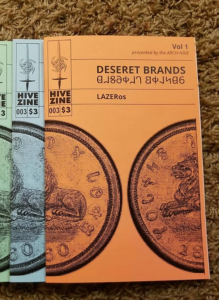 In many ways, the moment is again both distinctly Mormon, as well as millennial in the most current use of the term. These are new young artists, dedicated to creating community through the action of not just publishing, but extending in multiple forms of media and contemporary creative processes. In addition to the HIVE ZINES, the group produces a blog that encourages creative writing, podcasts, and several group art shows, collecting the best in a growing movement of contemporary Mormon art.
In many ways, the moment is again both distinctly Mormon, as well as millennial in the most current use of the term. These are new young artists, dedicated to creating community through the action of not just publishing, but extending in multiple forms of media and contemporary creative processes. In addition to the HIVE ZINES, the group produces a blog that encourages creative writing, podcasts, and several group art shows, collecting the best in a growing movement of contemporary Mormon art.
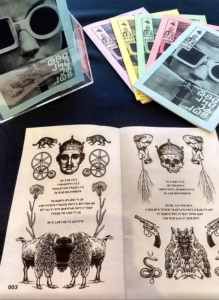 As Stark and Laz say themselves, “There is something in the water right now”. Something that longs to respond to rapid changes in both our niche culture of Mormonism, but also to a much larger mission of being a mirror to more than their own given culture. The HIVE in all of it forms is a reflection of a zeitgeist. Spirit and question is their brush of choice. Often moving in broad strokes, the collective is painting a mural of culture. The picture coming into focus with each venture is one of a growing community and of faith. It is a narrative healthy enough for not just question and controversy, but a story of resolve and simplicity, which is illustrated in the ease of the work.
As Stark and Laz say themselves, “There is something in the water right now”. Something that longs to respond to rapid changes in both our niche culture of Mormonism, but also to a much larger mission of being a mirror to more than their own given culture. The HIVE in all of it forms is a reflection of a zeitgeist. Spirit and question is their brush of choice. Often moving in broad strokes, the collective is painting a mural of culture. The picture coming into focus with each venture is one of a growing community and of faith. It is a narrative healthy enough for not just question and controversy, but a story of resolve and simplicity, which is illustrated in the ease of the work.
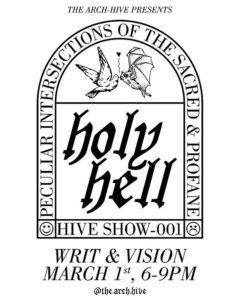 Often mythology is constructed after the making or event, and the meaning which is revealing itself is one in which the contemporary Mormon experience is the American experience. The HIVE ZINE is one more confident utterance of self-acceptance and determination in a larger revival of Mormon arts and letters.
Often mythology is constructed after the making or event, and the meaning which is revealing itself is one in which the contemporary Mormon experience is the American experience. The HIVE ZINE is one more confident utterance of self-acceptance and determination in a larger revival of Mormon arts and letters.
Special Award in Literature and Performance
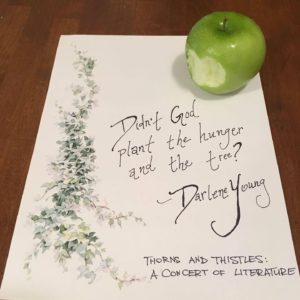 Thorns and Thistles: A Concert of Literature
Thorns and Thistles: A Concert of Literature
Curated and compiled by James Goldberg and Nicole Wilkes Goldberg. Directed by Ariel Rivera. Music by Nicole Pinnell. Presented at the Center for Latter-day Saint Arts Festival, June 29, 2019, in New York City.
The consumption of literature is largely solitary. Poetry readings, playwrighting, and adaptations for the stage are welcome exceptions, but how can literary works themselves be concertized for an audience? Thorns and Thistles provided a template worthy of emulation. Taking excerpts from novels, plays, poetry, essays, and non-fiction, the “Concert of Literature” told a three-act story with texts relating to the Garden of 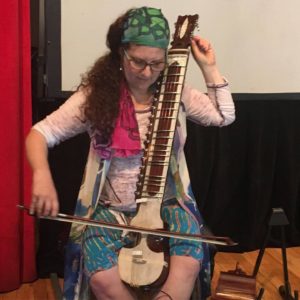 Eden, life in the wilderness, and “Harvest.” Performed by four actors, directed as a play, and with evocative and rueful cello accompaniment largely improvised by Nicole Pinnell, the work grouped twenty writers’ texts thematically into a counterpoint of themes, variations, and storytelling—all honouring the original works while combining into something boldly and persuasively new.
Eden, life in the wilderness, and “Harvest.” Performed by four actors, directed as a play, and with evocative and rueful cello accompaniment largely improvised by Nicole Pinnell, the work grouped twenty writers’ texts thematically into a counterpoint of themes, variations, and storytelling—all honouring the original works while combining into something boldly and persuasively new.
For members of the audience, Thorns and Thistles transcended any notion of a literary sampler. The concert work should serve as a rallying cry for poets, novelists, essayists, lyricists, and other page-bound artists to storm the stage.
Special Award in Literature
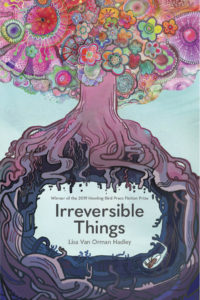 Lisa Van Orman Hadley. Irreversible Things. Howling Bird Press.
Lisa Van Orman Hadley. Irreversible Things. Howling Bird Press.
Comics
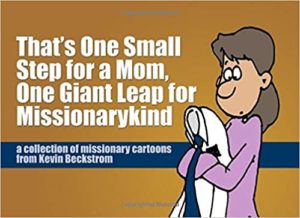 Kevin Beckstrom. That’s One Small Step for a Mom, One Giant Leap for Missionarykind.
Kevin Beckstrom. That’s One Small Step for a Mom, One Giant Leap for Missionarykind.
That’s One Small Step for a Mom, One Giant Leap for Missionarykind is the latest collection of cartoons from Kevin Beckstrom. As a cartoonist, Beckstrom is best known for his regular contributions to the New Era, the official youth magazine of The Church of Jesus Christ of Latter-day Saints. Yet most of his work has appeared on his personal comics blog BeckstromBuzz and his various social media platforms, where he has published a new comic or cartoon virtually every day for more than a decade. His simple, distinctive style has become instantly recognizable to Latter-day Saints throughout the world. And his charming sense of humor has made more than a few Latter-day teenagers chuckle at themselves and their fellow Saints.
That’s One Small Step delivers what it promises: smile-inducing cartoons about Mormon missionaries and the families that support them (from afar) for eighteen months to two years. It pokes fun at many of the situations that have become staples of the missionary experience: eccentric companions, unpredictable weather, hard-to-learn languages, and odd investigators. The cartoons are like the quirky snapshots in a missionary’s photo album, but they are also tributes to the young women and men who submit themselves to daily unpredictability in the cause of Jesus Christ and His message of peace. Indeed, Kevin Beckstrom’s cartoons remind us why we should value missionaries and their selfless service.
Other finalists:
Michael Allred, Lee Allred, Rich Tommaso, Laura Allred. Dick Tracy: Dead or Alive
Shannon Hale and LeUyen Pham. Best Friends
Matt Vroom. Super Elders & the Rise of Legion
Creative Non-Fiction
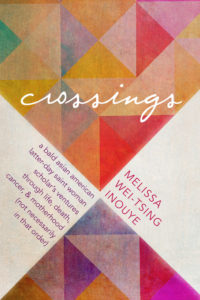 Melissa Wei-Tsing Inouye. Crossings: A Bald Asian-American latter-day saint woman scholar’s ventures through life, death, cancer, & and motherhood. Deseret Book/Maxwell Institute.
Melissa Wei-Tsing Inouye. Crossings: A Bald Asian-American latter-day saint woman scholar’s ventures through life, death, cancer, & and motherhood. Deseret Book/Maxwell Institute.
Inouye’s Crossings is a bold experiment in the Mormon memoir and in 21st century life writing in general. Setting aside traditional autobiography, Inouye has assembled something of a collage of different life-writing genres: personal letters to her children or her students, blog posts published on Patheos, socially sensitive musings on LDS theology, travel essays, family stories, annual Christmas letters (with personally penciled drawings), devotional reflections, parables, and the occasional bit of moral wisdom served up with palatable slices of Chinese history. One moment we are enjoying a short account of two strangers aiding her and her child traveling with a heavy suitcase across the train platforms of Shanghai; the next, she is philosophizing about coping with change (or the lack of it) in the church.
This is the sort of work that could have a certain superficial appeal due to the author’s diverse identities, captured in the book’s subtitle: “a bald Asian American Latter-day Saint woman scholar’s ventures through life, death, cancer & motherhood (not necessarily in that order).” But rather than creating of herself a curiosity, Inouye quickly grounds these identities within a framework of humility and empathy. “I am used to the feeling of being out of place,” she says, and through the range of her travels and trials we recognize just how much she has had reason to feel on the outside of things. But such marginality, she asserts, connects her with others and with God’s larger purposes: “We are all aliens, exiles, sojourners far from our spiritual home. The purpose of life is to come to terms with the depth of this alienation in ourselves and in others and respond with charity.”
Perhaps nowhere does Inouye model this charity better than in her thoughtful, patient essays opened to the pain felt by those who are unhappy with the Church of Jesus Christ of Latter-day Saints or who are immature or unsettled in their faith. Never does Inouye discount the real harms that continue to rankle our ranks due to racism, sexism, and other insensitivities; nor does she belittle the real anxieties of young or beleaguered believers. But, very much in the manner of Eugene England, Inouye plays peacemaker, unwilling to see present challenges as anything less than opportunities for deepened discipleship, more authentic charity, and more informed faith.
Inouye’s idiom is as fresh as her faith. LDS views about relationships are recast as “rich entanglements,” or “the peopled warp across which we must learn to weave our lives.” She justly earns our attention — not so much through eloquence as through a kind of everyday persistence across place and time, trials and travels — that in turn leaves us feeling as though she is a sister, a wise and well-meaning sister who isn’t afraid to be either candid or kind. In Crossings, Inouye becomes Mormonism’s modest Confucius: unassuming, authentic, and utterly trustworthy.
Other finalists:
James Goldberg. Remember the Revolution: Mormon Essays and Stories
Ashley Mae Hoiland. A New Constellation: A Memoir
Criticism
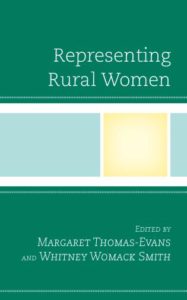 Amy Easton-Flake. “Poetic Representations of Mormon Women in Late Nineteenth-Century Frontier America”. In Representing Rural Women, Whitney Womack Smith, Margaret Thomas-Evans, editors. Lexington Books.
Amy Easton-Flake. “Poetic Representations of Mormon Women in Late Nineteenth-Century Frontier America”. In Representing Rural Women, Whitney Womack Smith, Margaret Thomas-Evans, editors. Lexington Books.
Amy Easton-Flake’s “Poetic Representations of Mormon Women in Late Nineteenth-Century Frontier America” accomplishes what the best criticism sets out to do: elevates the texts it engages with by illuminating new ideas and possibilities contained within it. Her essay, published in Representing Rural Women, is a deep, thoughtful engagement with a broad swath of poems from the Woman’s Exponent. Easton-Flake demonstrates her familiarity with the poetry in weaving a narrative that gives insight into the day-to-day lives of these Mormon women by drawing on the common themes of the poetry. The essay engages with the text of the poems as they are, finding meaning in what they say as a collective expression of values, while linking the text and themes to related historical contexts. Easton-Flake covers a lot of ground and demonstrates the richness that awaits others in giving time and effort to the poetic work of Mormon women.
Other finalists:
Michael Austin. “Danites, Damsels, and World Domination: Mormons in the Dime Novels.” Sunstone #183.
James Goldberg. “Wrestling with God: Invoking Scriptural Mythos in LDS Literary Work”. In James Goldberg, Remember the Revolution: Mormon Essays and Stories.
Jake Johnson. Mormons, Musical Theatre, and Belonging in America.
Brenda R. Weber. Latter-day Screens: Gender, Sexuality, and Mediated Mormonism.
Drama
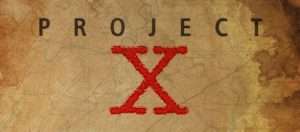 Taylor Hatch. Project X. MOD Theatre Company, Secret Theatre, New York City, March 28-April 7.
Taylor Hatch. Project X. MOD Theatre Company, Secret Theatre, New York City, March 28-April 7.
Project X is a family history beautifully constructed in real time. Richard, a man in his 80s dying of cancer, adds an addendum to his tape-recorded memories and in the process brings to life a compellingly almost unbelievable account of a family moving to a secret city in Tennessee in order to help with the war effort in World War II. After an unbearable amount of time his father, Robert, is notified that his assignment is to discover the effect of uranium on the human body. Without any resources because of the nature of the project and driven by the potential horrors that could be inflicted on his own wife and son, Robert is driven to test the ‘product’ on himself. This not only causes his own demise but also creates a rift the family may never recover from.
Hatch deftly navigates the secrets, mystery, and discovery that haunt almost every family story, by sharing the strength and choices that were specifically part of hers. This family shows what it means to have the deepest faith, faith enough to continue down a path of belief not knowing where it will lead or if you will ever return. Richard has the faith of a child believing in the actions of his parents without explanation. It is his faith that, even through adulthood, compels him to understand Robert and Freda’s actions and in the end share them with his own family, maybe even Hatch herself. Robert has the faith to actively choose to die in order to protect those he loves and what he believes in. And, maybe possessing the greatest faith of all, Freda chooses to not only stay but to support this man. This is belief. This is family. This is life. Hatch’s specific, creative, almost musical storytelling help us feel the meaning behind it all. It is an honor to name Project X the 2019 AML Drama Award Recipient.
Other finalists:
Carolyn Chatwin Murset. Tales of Tila
Melissa Leilani Larson. Bitter Lemon
Narrative Feature Film
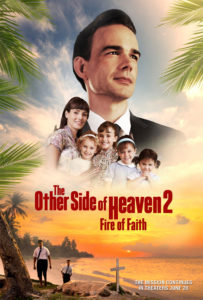 The Other Side of Heaven 2: Fire of Faith. Directed by Mitch Davis
The Other Side of Heaven 2: Fire of Faith. Directed by Mitch Davis
As Latter-Day Saint filmmaking continues to grow and mature, Fire of Faith follows suit, allowing the cinematic story of Elder John Groberg, last seen as a young missionary, to mature with wisdom and equanimity. Groberg, now a young father of five, is tasked with returning to Tonga to serve as president of the Tonga-Fiji mission. Full of harrowing adventure, incredible scope and impressive production value, Fire of Faith is also a moving expression of the need for unity to invite God’s healing and miracles. With strong performances and a beautiful score, Fire of Faith realizes an epic spiritual journey that rivals its predecessor, even while being produced on a leaner budget. Such a feat is testament to the skills of director Mitch Davis and his team of independent filmmakers (many of whom include his own family members, each skilled in their respective crafts).
But more importantly, the film shows us imperfect Church leaders struggling to find faith amidst hardship, imperfect congregations struggling against prejudice, and ultimately demonstrates that the perfect expression of a Zion community leaves space for all of God’s children to assert their love and prayers through diverse expressions of faith.
Other finalists:
The Fighting Preacher. Directed by T.C. Christensen
Out of Liberty. Directed by Garrett Batty
Documentary Feature Film
 Jimmer: The Lonely Master.Directed by Scott Christopherson
Jimmer: The Lonely Master.Directed by Scott Christopherson
The “nice guy” is rarely seen as the most interesting person in the room, especially in the world of the NBA, where there is no shortage of players with abundant egos, attitude and braggadocio. But in Jimmer: The Lonely Master, filmmaker Scott Christopherson applies his quiet attention to Jimmer Fredette, giving us a window into the heart of BYU’s golden boy who, after losing his coveted spot in the NBA, now finds himself living a world away from his wife and kids while working to make a comeback playing for China’s Shanghai Sharks.
Thanks to Christopherson’s deft touch, the film transcends the tropes of the traditional sports documentary to show us the loneliness of discipleship as Jimmer struggles through disappointment and isolation. The comeback story, as Jimmer leads the Shanghai Sharks to the finals, is compelling, but it’s the small and subtle moments of his insecurity and isolation that makes the film more than the sum of its parts. It’s in those fleeting, unguarded moments that we see that Jimmer’s commitment to greatness extends far beyond the sport.
As if trying to be the best pro basketball player isn’t hard enough, Jimmer is simultaneously trying to be the best husband, father and man that God wants him to be. His goodness is not pious or preachy, and Jimmer serves as a great example that the best way to share the light of the Gospel is to simply live it with humility.
This is a film about a young man with great skill and proven potential whose future is still very uncertain. But it’s in that uncertainty that we come to admire Jimmer’s commitment to greatness. It turns out being a “nice guy” is the hardest work of all.
Other finalists:
After Selma. Directed by Loki Mulholland
he Jets: Making it Real. Directed by Kels Goodman
Short Film
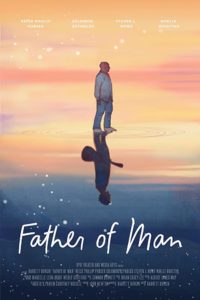 Father of Man. Directed by Barrett Burgin
Father of Man. Directed by Barrett Burgin
Father of Man boldly envisions the unique LDS doctrine of eternal progression (and therefore, post-mortal imperfection) through its main character Boyd, a flawed and unsupportive father who, after experiencing an untimely death, finds himself entrenched in the same weaknesses in the afterlife. Through an angelic guide, Boyd is given a warning that his still-mortal son is about to make a life-altering bad decision and that he is the only person who can lead his son to a better path. Complicating the matter, Boyd’s move to a post-mortal state only amplifies his impatience and inability to connect with his living son, bringing to cinematic realization Amulek’s treatise: “…for that same spirit which doth possess your bodies at the time that ye go out of this life, that same spirit will have power to possess your body in that eternal world.” (Alma 34:34).
Juggling dual narratives of flawed parents, a “ghost” story, and the challenges of listening to a “still, small” voice, Father of Man movingly depicts the need for familial reconciliation that extends eternally in all directions of space and time. Featuring a beautiful and bittersweet soundtrack and otherworldly visuals, the film bypasses the common Protestant concepts of a perfect and carefree afterlife, leaning instead into a network of imperfect individuals on all sides of the veil, each responsible for working together to repent, forgive and reconnect in order to achieve salvation.
Other finalists:
Paper Trails. Directed by Heather Moser
Stickup Kid. Directed by Daniel Tu
Man and Kin. Directed by Max Johnson
Middle Grade Novel
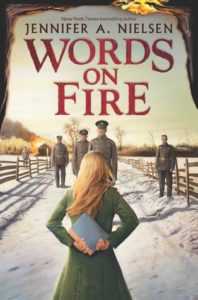 Jennifer A. Nielsen. Words on Fire. Scholastic
Jennifer A. Nielsen. Words on Fire. Scholastic
12 year-old Audra knew how to blend in and avoid being noticed, but nothing prepared her for the night Cossack soldiers showed up on her doorstep to capture her parents and burn her home. Left on her own with instructions from her mother to deliver a mysterious package, Audra must start on a journey filled with unthinkable risks that will lead her to discover the power of words and the strength that can be gathered from uniting in the fight for freedom from an oppressor. Nielsen draws readers into a pocket of Lithuanian history many may be unfamiliar with as they follow Audra’s life as a Lithuanian book smuggler. This is the story of how a small spark of courage becomes a flame to be reckoned with.
Other finalists:
Josh Allen. Out to Get You: Thirteen Tales of Weirdness and Woe
Kate Coombs. The Red Flower
Liesl Shurtliff. Time Castaways: #1 The Mona Lisa Key and #2 The Obsidian Compass
Novel
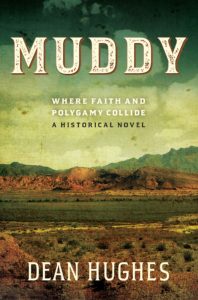 Dean Hughes. Muddy: Where Faith and Polygamy Collide. Deseret Book
Dean Hughes. Muddy: Where Faith and Polygamy Collide. Deseret Book
Dean Hughes continues his long record of excellence in LDS historical fiction with Muddy. He also continues to challenge his LDS audience to confront the more difficult and uncomfortable aspects of our history. The novel follows the experience of a pioneer couple, Morgan and Abigail, who obey Brigham Young’s call to colonize a remote and arid part of the mountain West. In their struggle to eke out a living with their fellow saints, the couple encounters additional trials, including infertility, polygamy, forced relocation, and backbreaking labor. Hughes enriches the story with many historically accurate details of daily life that highlight how pioneers lived.
Hughes creates characters who are intensely devoted to their faith yet experience human doubts about the value of attempting to settle the town of Muddy and practice polygamy. Morgan’s attempts to comfort his second wife, Abigail’s guilt about her own jealousy, and the realization that their relationship has permanently changed all feel real and sympathetic. Hughes portrays the difficulties of polygamy with great honesty and in painful detail, while also illustrating the reasons some chose to accept the practice. Hughes also addresses the distinction between prophetic vision and personal revelation when Brigham Young finally visits the settlement and expresses his opinion that the location is unfit for habitation, an incident taken from historical events. The struggles Hughes’s characters have with prophetic authority, obedience, fertility, and faith through trials are still relevant today.
Other finalists:
D. J. Butler and Aaron Ritchey. The Cunning Man
Lisa Van Orman Hadley. Irreversible Things
Annette Haws, Maggie’s Place
Ann Weisgarber. The Glovemaker
Picture Book
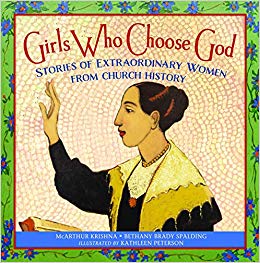 McArthur Krishna, Bethany Brady Spalding (authors), Kathleen Peterson (illustrator). Girls Who Choose God: Stories of Extraordinary Women from Church History. Deseret Book
McArthur Krishna, Bethany Brady Spalding (authors), Kathleen Peterson (illustrator). Girls Who Choose God: Stories of Extraordinary Women from Church History. Deseret Book
Girls Who Choose God is a engagingly written collective biography of 15 notable historical women in the Church of Jesus Christ of Latter-day Saints. Anchored by many recognizable names such as Lucy Mack Smith, Emma Hale Smith and Emmeline B. Wells, it also includes some women whom many readers may not know, like Desideria Quintanar de Yanez. Each biography includes a decision in her life that encourages an interactive answer from the reader. In the case of Desideria, her choice was that “She could ignore her dream or she could believe her dream was a vision and search for the booklet.” This biography ends with “when have you chosen to act on a message from God?”
Each story is beautifully illustrated in warm hues that mimic historical photos with sepia tones. Every biography also has a bordered illustration with details of the life and times of the subject.
The simple, personal stories are perfectly complemented and extended by Peterson’s expert illustrations. Girls Who Choose God can be enjoyed by any age, but is well suited for 3rd- 5th graders.
Other finalists:
Camille Andros and Tessa Blackham. From a Small Seed: the Story of Eliza Hamilton
Amy Newbold and Greg Newbold. If Monet Painted a Monster
Kenneth Wright and Sarah Jane Wright. Lola Dutch: When I Grow Up
Poetry
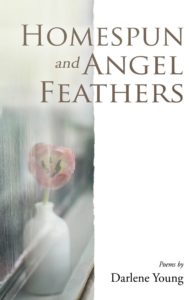 Darlene Young. Homespun and Angel Feathers. BCC Press.
Darlene Young. Homespun and Angel Feathers. BCC Press.
Darlene Young “has lived in [her] poetry at the same time that [she] has lived outside of it, and…[this] is why we know that [her] poems mean exactly what [she] means, and might say in some other language if [she] chose. But [she] has chosen this language as the most personal [she] could find, toward the end that what it conveys should be personal for us too. We need not agree with everything [she] says in order to think [her] wise…. Some of [her poems] are very narrow, it would seem, and…in the language of criticism they might even be dismissed as little ‘conceits’; but the narrowest of them is likely to lead further in than we suspected, toward the central room where [her] understanding is at home.
“The sign that [she] is at home is that [her] language is plain; it is the human vernacular, as simple on the surface as monosyllables can make it. [She] seems to be saying less than [she] does; it is only when we read close and listen well, and think between the sentences, that we become aware of what [her] poems are about. What they are about is the important thing—more important, we are tempted to think, than the words themselves, though it was the words that brought the subject on. [And this] subject is the world…which [we] will never quite understand, [yet] it is as familiar as an old boot or an old back door, lovable for what it is in spite of the fact that it does not speak up and identify itself in the idiom of abstraction. [Young] is a philosopher, but [her] ideas are behind [her] poems, not in them—buried well, for us to guess at if we please.”
The above is a 1951 description of Robert Frost’s role in the world’s literature by the poet and scholar Mark Van Doren, but it captures perfectly the parallel role Darlene Young’s poems are shaping for themselves within the landscape of Mormon literature. Just as Robert Frost (alongside yet in contrast to the Modern poets) wrote of everyday things in everyday language, heightening both in the process, Young, during a golden era of Mormon poets publishing provocative work, writes of everyday life as a “Utah Mormon” with language that elevates the mundane to the heroic and the beautiful.
Homespun and Angel Feathers quietly sits among its peers with less flash or surface difficulty, yet it more directly, consistently, and deeply engages with themes and paradoxes of Latter-day Saint life—all while maintaining a surface friendly to casual readers who simply want a spot of pleasure from beautiful language, easily understood. That she manages both these tasks with consistent wit and true feeling places this collection among not just the best of 2019, but among the greatest works in our literature generally. We only hope that her first collection, like Frost’s before her, augurs decades of important, accessible, challenging work to follow.
Other finalists:
Colin Douglas. Into the Sun: Poems Revised, Rearranged, and New
Michael Lavers. After Earth
Kathryn Knight Sonntag. The Tree at the Center
Sunni Brown Wilkinson. The Marriage of the Moon and the Field
Religions Non-Fiction
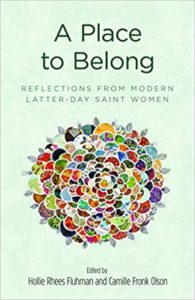 Hollie Rhees Fluhman and Camille Fronk Olson, editors. A Place to Belong: Reflections from Modern Latter-day Saint Women. Deseret Book.
Hollie Rhees Fluhman and Camille Fronk Olson, editors. A Place to Belong: Reflections from Modern Latter-day Saint Women. Deseret Book.
Latter-day Saint women across the world represent a vast array of testimonies and backgrounds, offering unlimited possibilities for sharing and connection. Every woman has a story, and a A Place to Belong proves that every story is worth sharing.
Seamlessly incorporating both radical displays of feminism and tender expressions of faith, this book is accessible to members of every kind. Don’t misunderstand its gentle approach, though–A Place to Belong challenges readers to reevaluate any preconceived notions they may have had about Latter-day Saint women.
Readers will be struck by the expansive scope of voices in A Place to Belong. The diverse list of contributors includes a Palestinian-born BYU-Idaho professor, the first African-American missionary in Chile, the winner of the 2019 Woman of the Decade by the Women’s Economic Forum, mothers, single women, members of the LGBTQ community, and more. This collection of stories demonstrates that there are countless ways to live a Mormon faith strongly rooted in feminism and attention to women’s issues. We are proud to choose such an inclusive and empowering book to receive the Association for Mormon Letters award for religious nonfiction.
Other finalists:
George B. Handley. If Truth Were a Child: Essays
Jana Riess. The Next Mormons: How millennials are changing the LDS Church
Short Fiction
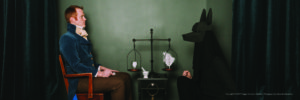 Karen Rosenbaum. “Next of Kin”. Irreantum, Winter.
Karen Rosenbaum. “Next of Kin”. Irreantum, Winter.
Grace: something elegant in movement and expressive of goodwill. “Next of Kin,” by Karen Rosenbaum, epitomizes literary grace with its gentle but sophisticated unfolding of a family saga that feels as if it is our own. Wholly realistic, Rosenbaum’s tale opens human frailty to our view as if by revelation, slowly bestowing light on darkness and drawing from our souls empathy rather than judgment. She offers us the very Mormon idea that humans decide whether to love and forgive, and they must reckon with faith that promises answers it cannot yet provide. Whatever that reckoning may yield, Rosenbaum’s characters choose to press on in the face of sorrow, limitation, and other serious troubles. Such actions are graceful, more important than resolution. These conundrums are both the shadow and light of “Next of Kin,” a short story made wondrous by a master’s hand.
Other finalists:
Alison Maeser Brimley. “You Can Give Him a Kiss”. Sunstone, #188.
Danny Nelson. “My Father’s Liahona”. In Press Forward Saints: A Mormon Steampunk Anthology.
Levi Peterson. “Bode and Iris”. Dialogue, Summer 2019.
Young Adult Novel
 Julie Berry. Lovely War. Viking
Julie Berry. Lovely War. Viking
Written as a multi-layered frame narrative, Julie Berry’s Lovely War presents the love stories of two couples—Hazel and James, Colette and Aubrey—caught in the grips of World War I. Their captivating romances intensify simultaneously with the tragedies and horrors they experience in the war, tugging readers’ heartstrings in unexpected and poignant ways throughout the novel. Creatively blending romance, war, and Greek mythology, Berry’s novel also speaks to audiences dealing with racism, sexism, heartbreak, or fading hopes. Readers young and old will be enchanted, shattered, and renewed as they glimpse the collision of love and war in this book.
Other finalists:
Katie Henry. Let’s Call it a Doomsday
Erin Stewart. Scars Like Wings
Spencer Hyde. Waiting for Fitz

Congratulations to all the winners. Watched along in real time, but lacking a youtube account (and lacking any interest in getting one), I didn’t join in on the streaming conversation with fellow AMLers. A big thank you to Theric (and his alter-ego) for the online presentation. Hopefully next year, we’ll be back to face-to-face meetings. And thanks also to Andrew Hall for all his behind the scenes work.
.
Thanks, Lee! I’m surprisingly happy to learn you were there. So: thank you.